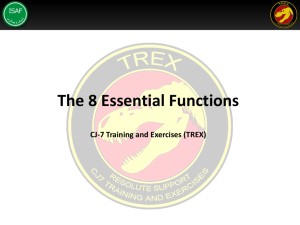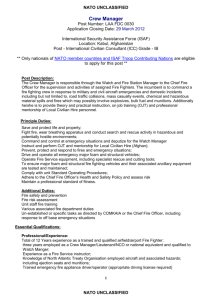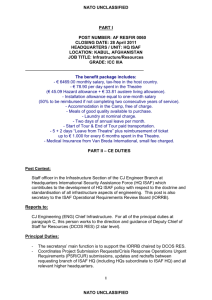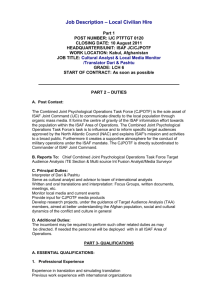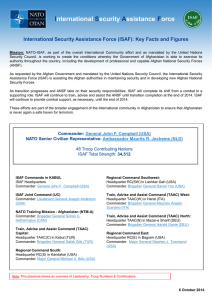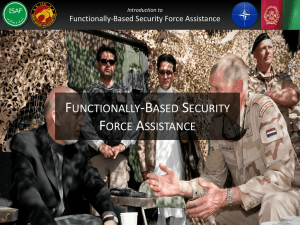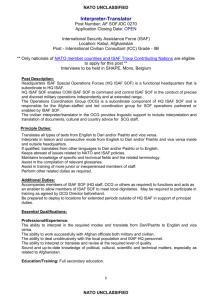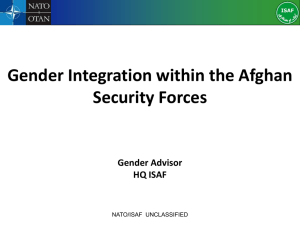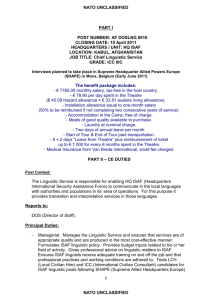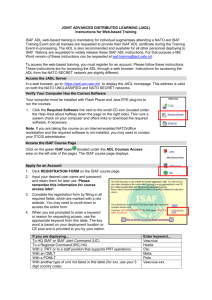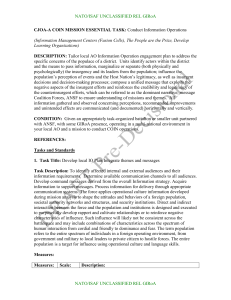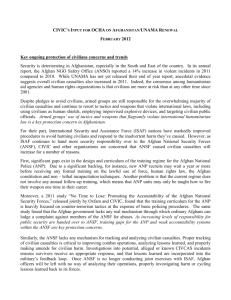20140914_NIU_CJ7_TREX_Lesson_2b_Essential_Functions
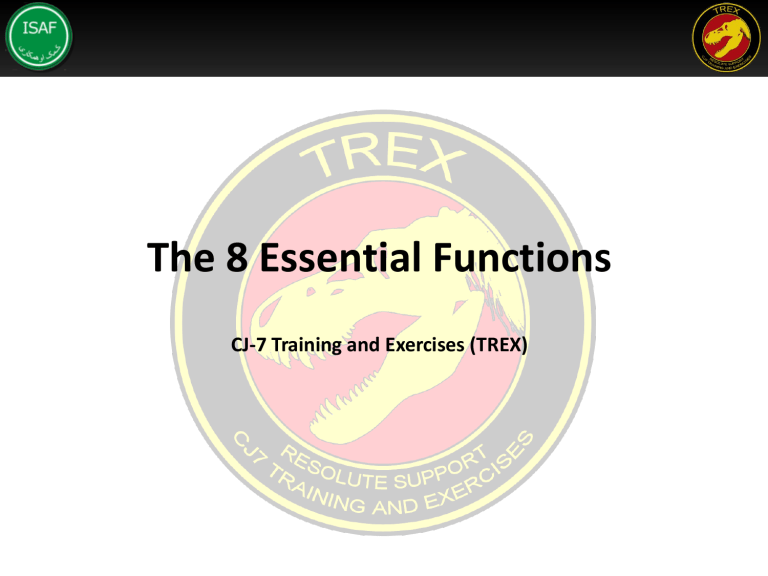
The 8 Essential Functions
CJ-7 Training and Exercises (TREX)
Content
1. The 8 EF’s
(know what are they and why were they developed)
2. Alignment EF’s with ASI/ANSF
(know it is not an isolated CF-system)
3. Process Maps
(know what they look like)
Background
• Security Force Assistance (SFA) matured from 5 Functional
Pillars (FPs) to 8 Essential Functions (EFs);
• 5 Pillars too tactically focused (fight the war)
• 8 Essential Functions necessary to (sustain the ANSF)
– EFs integrate advisors @ ministerial, institutional, & fielded force levels
– Achieve ASI/ANSF sustainability
– Focus GIRoA/CF problem-solving
– Maintain IC support
– Enable ASI/ANSF to fight insurgency
– Enable withdrawal of CF
3
OPPLAN CONOPS
• The 8EF are Afghan system focus areas. These functions are interdependent and, taken as a whole, contribute to Afghan sustainability. They span across all levels of conflict, from the tactical to the strategic.
• Each Essential Function consists of Afghan systems, processes, and organizations necessary to implement the Function. These systems, processes, and organization have friction points, which prevent efficient flow of information and resources.
• Advisors focus on influencing these processes; however advisors should not directly impact the process. Afghan sustainability must evolve in a way that allows for enduring progress.
EF 1
PPBE
From 5 Pillars to 8 Essential Functions
EF 4
Force Gen
EF 5
Sustainment
EF 2
TAO
EF 3
CivGov/RoL
EF 6
ESC
EF 7
Intelligence
EF 8
StratComm
The processes found in the 5 Functional Pillars were re-assigned to the
8 Essential Functions
5
NATO/ISAF UNCLASSIFIED
The 8 Essential Functions
The 8 Essential Functions provide the framework and desired outcomes in target areas to achieve Afghan sustainability.
Each EF contains a series of Afghan processes with tactical, operational, and strategic characteristic, all of which may have interactions across other EFs.
This multi-echelon level of advising and cross-functional coordination allows analysis of Afghan process issues through multiple lenses.
6
NATO/ISAF UNCLASSIFIED
Essential Functions 1 - 4
Plan, Program, Budget and Execute; generate requirements, develop a resource informed budget and execute a spend plan. (PPBE)
Internal controls to assure Transparency, Accountability, and
IC SUPPORT
Civilian governance of the ASI, including adherence to the
Rule of Law. (ROL)
Force Generate; recruit, train, retain, manage and develop a professional ANSF. (FORGEN)
7
NATO/ISAF UNCLASSIFIED
Essential Functions 5 - 8
Sustain the force through effective facilities management,
FACILITATE
Plan, resource and execute effective security campaigns and operations. (ESC)
AIM
Sufficient Intelligence capabilities and processes. (INTEL) capabilities. (STRAT COMM)
NATO/ISAF UNCLASSIFIED
8
2. Alignment with ASI/ANSF priorities
NATO/ISAF UNCLASSIFIED
MINDEF Priorities
1. Win the current fight
2. Long-term sustainment of the Force
3. Facilitate a peaceful political transition
4. Close the capability
Gaps
5. Develop border security strategy
6. Develop leaders /
Educate the force
7. Implement viable counter-corruption program
8. Strengthen institutional capacity
9. Individual and collective training at the unit level
10. Budget Development and Execution
2. EF alignment with MOD / MOI
Essential Function Priorities
ESSENTIAL FUNCTION 2
1 ISAF identify ASI/ANSF individual(s) responsible for TAO, individuals responsible for development and/or compliance with internal controls, oversight organizations and their authorities; Ministers review/approve/advocate for current or new authorizations for oversight organizations
2 MoI/MoD establish an empowered Ministerial Internal Controls Program (MICP). Focus on unit readiness, effectiveness, review of controls. Reports inform IC for
Chicago/TMAF/Commitment Letter compliance
3 ASI/ANSF leaders conduct a review of critical financial & non-financial processes, assess current controls; Implement a plan to strengthen or establish new controls
ESSENTIAL FUNCTION 3
1 Monitor, report, investigate and adjudicate allegations of GVHR and EJV/EJK; internal disciplinary matters
2 Use of ANSF internal disciplinary procedures to investigate and adjudicate violations
3 Encourage institutionalization and effectuation of professionalization training (including on new laws), to facilitate coordination and communication between ANSF and Rule of Law actors, and to establish effective and transparent criminal and disciplinary systems.
ESSENTIAL FUNCTION 4
1 Support ANA clarification of the roles, C2, structure, resourcing (including training gap analysis) and relationship of Corps Training Kandaks and Branch Schools.
2 TED COMD established/define roles/ responsibilities of training & education enterprise leadership
3 Strengthen TGC C2 over ANP training enterprise
4 Educate ANA about strategic management capability of AHRIMS & build confidence in automated personnel processes
ESSENTIAL FUNCTION 8
1. Sustain Security News Desk capability
2. Sustain School of Public Affairs
3. Sustain AIDO capability
4. Train ANA leaders on IO capabilities
5. Sustain GMIC capacity
MININT Priorities
1. Post Election Security
2. Highway & Convoy
Security
3. Provincial Security
4. Budget Execution &
Development
5. Ministerial / Political
Transition
6. Fight against
Corruption
7. Logistics and
Sustainment
8. Inter-ministerial
Security Coordination
9. International Standards
10. Professionalization of
MoI
10
2. PRIORITIES FOR MoI/MoD
Example as of : 12 Aug 2014
MoI as at 12 Aug 14 MoD as at 17 Jul 14
Priority
1. Close
MINDEF Priorities
Win the current fight – defeat the insurgency
OPR
EF 6
2. Deep
3. Deep
4. Close
Long-term sustainment of the force
Facilitate a peaceful political transition
Close the capability gaps
EF 5
EF 3
EF 4/6
5. Close
6. Deep
7. Deep
8. Deep
9. Close
Develop border security strategy
Develop leaders / educate the force
Implement viable counter-corruption program
Strengthen institutional capacity
Individual and collective training at the unit level
EF 6
EF 4
EF 2/3
N/A
EF 4
Priorities
1. Close
2. Close
3. Close
CoGS Priorities
Sustained security operations
ANA support to movement of election materials
Inauguration Security
OPR
EF 6
EF 6
EF 6
Priorities
4. Deep
5. Close
6. Close
CoGS Priorities
Base transition and security
Addressing capability gaps
Sustaining current capabilities – logistics, maintenance, supply
OPR
EF 5
EF 4,6
EF 5
NATO/ISAF UNCLASSIFIED
3. Process Maps
Maybe western visualization of Afghan process but:
- Are being made by former advisors ICCW Afghan counterparts
- Visualize extensive advisor efforts
- Are the best tool available to investigate and solve problems
- Are the means to minimize patronage/regional influence on Afghan systems
- Are essential for nation building
- Are essential to achieve sustaining ANSF
ANNEX B in Guide!
NATO/ISAF UNCLASSIFIED
EF 4 Force Generation
NATO/ISAF UNCLASSIFIED
B 15 Process Map
EF 5 Force Sustainment
NATO/ISAF UNCLASSIFIED
B 19 Process Map
References
Terms of Reference for Operationalizing Functionally-Based Security Force Assistance http://portal.hq.ms.isaf.nato.int/DCOSOPS/CJ3/CJ%2035/SFAFUSION/default.aspx
Operationalization of Functionally Based Security Force Assistance Handbook v 1.1
http://workspace.hq.ms.isaf.nato.int/IHQ/DCOSOPS/CJ3/SFA_Fusion_Cell/Documents/ISAF/08_SF
A_Key_Documents/Operationalization_of_FB_SFA_Handbook_Version_1.1.pdf
FRAGO 1001-2014 Operationalization of FB-SFA http://workspace.hq.ms.isaf.nato.int/IHQ/RecordsCentre/Documents/2014/20140607-NIU-IHQ-
FRAGO-1001-2014_Operationalizing_FB-SFA.pdf
RS Security Force Assistance Guide 3.0 http://workspace.hq.ms.isaf.nato.int/IHQMM/CGHQ/CAAT/Documents/Bi-
SC/FBSFA%20Rollout%20-%20Jul2014/2014.07.02.SFA%203.0%20Final%20v2.pdf
SFA Centre Portal http://portal.hq.ms.isaf.nato.int/DCOSOPS/CJ%2035/SFAFUSION/default.aspx
SFA Collaboration Site http://portal.hq.ms.isaf.nato.int/CGHQ/CAAT/SFA_Collaboration_Site/default.aspx
CAAT Portal http://portal.hq.ms.isaf.nato.int/CGHQ/CAAT/default.aspx
NATO/ISAF UNCLASSIFIED
